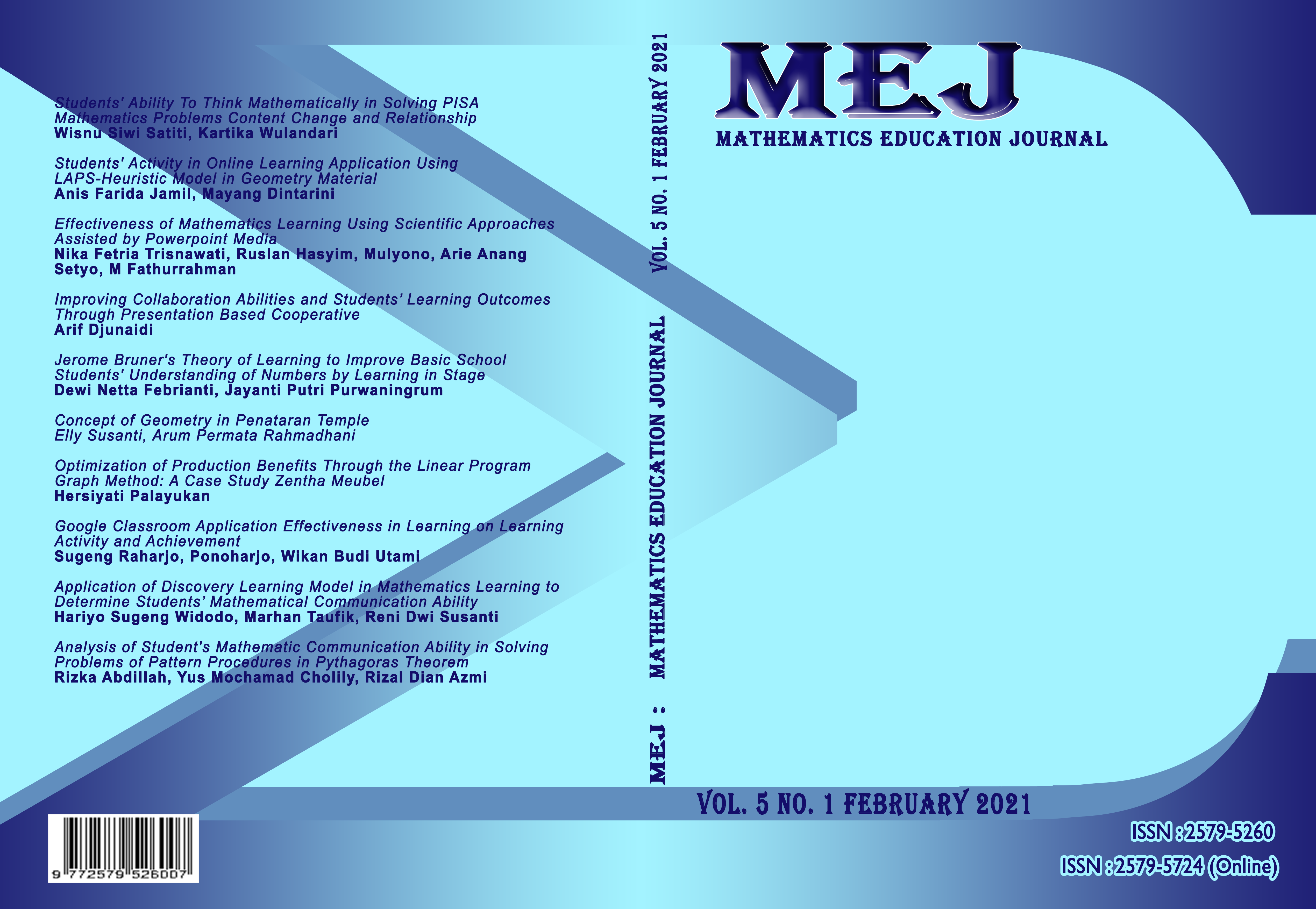Jerome Bruner's Theory of Learning to Improve Basic School Students' Understanding of Numbers by Learning in Stage
DOI:
https://doi.org/10.22219/mej.v5i1.15047Abstract
Mathematics is a subject that is disliked by most students. This has resulted in a lot of children who are not enthusiastic about this lesson since elementary school. Elementary school is a place where children start knowing what numbers are, what numbers are and how a number looks. Numbers become the basis for children before learning about mathematics. There are so many branches in numbers that children need to know, starting from the basics of numbers, namely natural numbers, developing into whole numbers, whole numbers, and fractions. This is why the methods of learning mathematics must be well determined, at this time many learning methods have emerged with various criteria. Because of this, the writer tries to find the right theoretical solution according to the number material which has developing properties, the method that can be used is the Bruner Theory, which is to learn by understanding the basics first before proceeding with something that is more difficult because mathematics is an abstract concept.
Downloads
References
Andi Yunarni Yusri, & Sadriwanti Arifin. (2018). Desain pembelajaran kooperatif berbasis teori bruner untuk meningkatkan kualitas pembelajaran matematika. Histogram : Jurnal Pendidikan Matematika, 2(2), 147–158.
Buto, Z. A. (2010). IMPLIKASI TEORI PEMBELAJARAN JEROME BRUNER DALAM NUANSA PENDIDIKAN MODERN. Millah : Edisi Khusus, 55–70.
Evi, S. (2011). Pendekatan Matematika Realistik (PMR) untuk Meningkatkan Kemampuan Berfikir Siswa di Tingkat Sekolah Dasar. Jurnal Penelitian Pendidikan, Edisi Khus(2), 154–163.
Hasil, P., Siswa, B., Menggunakan, D., Pembelajaran, M., Learning, A., Quiz, T., Pada, T., Pelajaran, M., Dasar, K., Di, K., & Negeri, S. M. K. (2010). Peningkatan Hasil Belajar Siswa Dengan Menggunakan Metode Pembelajaran Active Learning Tipe Quiz Team Pada Mata Pelajaran Keterampilan Dasar Komunikasi Di SMK Negeri 1 Bogor – Maisaroh dan Rostrieningsih. Ekonomi Dan Pendidikan Pendidikan, 8(2), 157–172.
Kampung, D. I., Pu, R., Muliani, M. M., Makur, A. P., Kurnila, V. S., & Sutam, I. (2020). Journal of honai math. 3(1), 57–76.
M.Primasti. (2019). NOL. Computers in Human Behavior, 63(May), 9–57. http://dx.doi.org/10.1016/j.chb.2016.05.008
Marogi, A., Hidayat, S., Guru, P., Dasar, S., Pendidikan, U., Kampus, I., & Pendahuluan, A. (2016). Pengembangan Multimedia Pembelajaran Interaktif Berbasis Flash Model Simulasi Pada Materi Pengenalan Konsep Bilangan Bulat. 292–302. https://ejournal.upi.edu/index.php/pedadidaktika/article/viewFile/5160/3623
Nurisa. (2018). Meningkatkan Hasil Belajar Matematika Dengan Menerapkan Teori Bruner Di Kelas III A SDN 005 Batu Gajah Kabupaten Indragiri Hulu. Jurnal Mitra Guru, IV(3), 453–467.
Priatna, N., & Yuliardi, R. (2019). Pembelajaran Matematika untuk Guru SD dan Claon Guru SD (N. N. Muliawati & P. Latifah (eds.); 1st ed.). PT REMAJA ROSDAKARYA.
Rijal, S. (2016). Efektivitas Pembelajaran Matematika Siswa melalui Penerapan Teori Belajar Bruner. Prosiding Seminar Nasional, 02(1), 489–495.
Safitri, A. S., Mulyati, S., & Chandra, T. D. (2017). Kemampuan Number Sense Siswa Sekolah Menengah Pertama Kelas VII pada Materi Bilangan. Prosiding SI MaNIs (Seminar Nasional Integrasi Matematika Dan Nilai Islami), 1(1), 270–277.
Sidik, G. S., & Wakih, A. A. (2006). KESULITAN BELAJAR MATEMATIKA SISWA SEKOLAHDASAR PADA OPERASI HITUNG BILANGAN BULAT. Naturalisitic : Jurnal Kajian Penelitian Dan Pendidikan Dan Pembelajaran, 4(1), 461–470.
Sutiadi, A. (2013). Pembelajaran Jerome Bruner untuk Meningkatkan Hasil Belajar Siswa. Jurnal Geliga Sains, 2(1), 1–6. https://ejournal.unri.ac.id/index.php/JGS/article/view/1581
Tambychik, T., Subahan, T., & Meerah, M. (2010). Students’ Difficulties in Mathematics Problem-Solving: What do they Say? Procedia Social and Behavioral Sciences, 8, 142–151. https://doi.org/10.1016/j.sbspro.2010.12.020
Zuliana, E., Retnowati, E., & Widjajanti, D. B. (2019). How should elementary school students construct their knowledge in mathematics based on Bruner’s theory? Journal of Physics: Conference Series, 1318(1). https://doi.org/10.1088/1742-6596/1318/1/012019
Downloads
Published
Issue
Section
License
Copyright (c) 2021 Dewi Netta Febrianti, Jayanti Putri Purwaningrum

This work is licensed under a Creative Commons Attribution-ShareAlike 4.0 International License.
Authors who publish with MEJ (Mathematics Education Journal) agree to the following terms:
For all articles published in MEJ, copyright is retained by the authors. Authors give permission to the publisher to announce the work with conditions. When the manuscript is accepted for publication, the authors agree to automatic transfer of the publishing right to the publisher.
Authors retain copyright and grant the journal right of first publication with the work simultaneously licensed under a Creative Commons Attribution-ShareAlike 4.0 International License that allows others to share the work with an acknowledgment of the work's authorship and initial publication in this journal.
Authors are able to enter into separate, additional contractual arrangements for the non-exclusive distribution of the journal's published version of the work (e.g., post it to an institutional repository or publish it in a book), with an acknowledgment of its initial publication in this journal.
Authors are permitted and encouraged to post their work online (e.g., in institutional repositories or on their website) prior to and during the submission process, as it can lead to productive exchanges, as well as earlier and greater citation of published work (See The Effect of Open Access).

This work is licensed under a Creative Commons Attribution-ShareAlike 4.0 International License.










